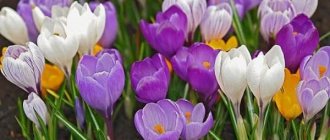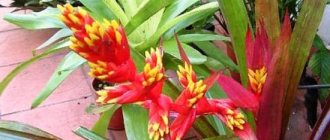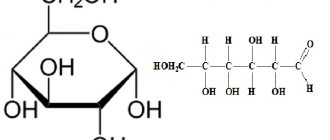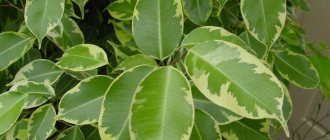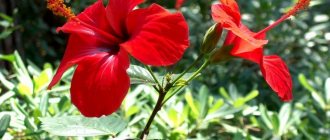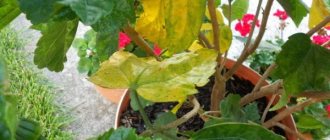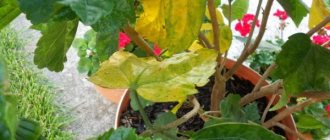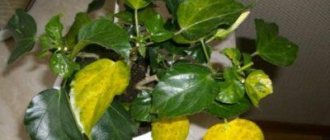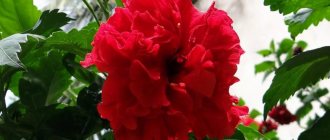Why feed hibiscus?
Why fertilize the plant at all? Isn't there enough water and the substances in the soil? No, not enough! The soil tends to deplete; over time, the hibiscus will “eat” most of the necessary substances, and then it will be necessary either to doom the flower to death, or to replant it, which is not always possible, or to fertilize it.
Also, fertilizing can play not only a supporting role, but also a stimulating one: thanks to them, the plant will bloom better and grow taller and faster.
You need to carefully monitor how much fertilizer has been added. Feeding is not a case where “the more, the better.”
Signs of Fertilizer Lack
A lack of nutrients in a plant is indicated by:
- deformation of leaves (thinning, drying), change in their color;
- delay or complete cessation of growth;
- reduction of the flowering period;
- reduction in flower size;
- weakening of the root system and its ability to absorb beneficial components;
- suspension of the formation of buds and side shoots.
- tendency to frequent illnesses.
Types of fertilizers: how to choose the right one
All fertilizers for hibiscus can be divided into the following categories:
- To keep the plant alive.
- For the development of hibiscus (Whether it is flowering or accelerated growth).
- To prevent diseases/combat their consequences.
It is important to know that absolutely all fertilizers are divided into two groups, differing both in effect and dosage:
- Organic fertilizers.
- Inorganic fertilizers.
You need to choose fertilizer for hibiscus depending on its needs and the desires of the gardener.
Required soil composition for hibiscus
The new substrate into which the hibiscus was transplanted already contains a lot of nutrients, so fertilizing after the transplant is completed only needs to be done after a few months. The flower is transplanted in April and fed from September to March.
Hibiscus is suitable for any universal fertilizer for houseplants, low in nitrogen, in liquid form or in the form of sticks.
Hibiscus is unpretentious and can grow in any universal soil for flowering plants. To make the soil loose and breathable, you can add raising agents: perlite or vermiculite. Vermicompost in small quantities will increase the nutritional value of the soil in order to “feed” a powerful bush with a large mass of leaves and numerous flowers. The acidity of the soil should be close to neutral: pH 6–7, so the plant optimally absorbs nutrients. At the bottom of the pot you need drainage from a layer of expanded clay so that the roots can “breathe”.
The source of nutrition for indoor hibiscus, also called Chinese rose, is the soil in which it grows. It is important to take care of the correct composition of the soil to provide the flower with favorable growing conditions.
For normal development, ornamental crops need moisture- and breathable soil. Experienced flower growers recommend not to immediately plant a flower in heavy commercial soil containing peat. It will need to be pre-enriched with leaf humus. This component will help improve the structure of the soil and increase its moisture capacity. You can also use sand and turf soil as an additive. It is advisable to introduce charcoal or ash into the soil for growing hibiscus (the input rate is 2 cups and 10 kg of soil).
Hibiscus thrives in slightly acidic soil (pH 6.8). If the acidity of the soil does not correspond to the recommended value, the ornamental crop will not be able to fully absorb the nutrients it contains.
Possible difficulties in growing Chinese roses
With some violations, deviations in the growth and development of the plant occur. A clear understanding of the causes helps to successfully combat such problems, preventing their occurrence.
Why doesn't the Chinese rose bloom?
Problems with hibiscus flowering often arise when it is kept in an apartment. Why the plant does not bloom can be understood if we analyze the conditions necessary for the formation of buds in winter.
Among them are the following requirements:
- moderate, minimized watering, which is designed to prevent the soil from drying out;
- bringing the ambient temperature to +15 degrees;
- reducing the light intensity to light partial shade.
Following these rules will create all the prerequisites for lush spring flowering.
After the appearance of young green leaves at the end of February, you need to move the flower to a warmer, bright place. The amount of water and fertilizer should be gradually increased. After this, the hibiscus will bloom.
Why do leaves turn yellow in summer?
The cause of yellowing and falling leaves in the summer is most often chlorosis. It is caused by a high concentration of chlorine and calcium in the water used for irrigation. In this case, the irrigation liquid is characterized by a lack of iron and nitrogen. Summer leaf fall can be caused by diseases of the root system or too dry air. Taking into account all these nuances, you can prevent the occurrence of such problems when keeping flowers at home.
Other Possible Problems
When growing a plant at home, certain problems may arise. For example:
- the buds that appear do not open and fall off due to poor watering, soil poor in nutrients, drying out, and cold;
- lack of flowers on a too lush crown, which can be caused by insufficient lighting, excess fertilizer, high temperature during winter maintenance;
- falling of the lower leaves due to a lack of iron and nitrogen, low temperature, excess calcium and chlorine in the soil.
In addition, with a lack of moisture, the leaves dry out and become limp, and the roots dry out in cold soil.
It will also be interesting: Clerodendrum Ugandan - caring for the plant at home?
Fertilizer
How to feed indoor hibiscus?
In spring and summer, it is recommended to feed the plant with mineral fertilizers that contain nitrogen at least once a month. In winter, it is worth reducing fertilizing with nitrogen-containing fertilizers and starting to use fertilizer with a high content of phosphorus and potassium. It is also recommended to alternate and once a month, instead of mineral fertilizers, feed the hibiscus with mullein or bird droppings diluted with water in a ratio of 1:10.
You can fertilize your tea rose weekly with special complexes for indoor plants.
Among other things, the shrub needs magnesium, a lack of which can cause the leaves to turn yellow. Feeding is carried out on cool days, preferably early in the morning or late in the evening. It is necessary to fertilize only after watering the hibiscus.
Minerals
Many gardeners prefer mineral products. They contain all the nutrients necessary for Chinese rose. For normal development, decorative culture needs:
- Azote. Ensures flower growth, green mass growth, and root system development.
- Potassium. The substance is necessary for the normal course of metabolic processes in a green organism, photosynthesis. Promotes better budding.
- Phosphorus. Promotes root growth, strengthens the plant’s immunity, and makes it more cold-resistant.
The most suitable mineral fertilizers for indoor hibiscus are the following, including:
- Urea. It is used for foliar feeding, produced by spraying on the leaf. To obtain a nutrient liquid, dissolve urea (1 g) in water (1 l).
- Calimagnesia. The fertilizer is rich in potassium and magnesium. It is used to avoid falling leaves, deformation of leaf blades and pathological changes in their color.
Experienced gardeners advise resorting to feeding hibiscus with store-bought complex preparations such as:
They will help the Chinese rose:
- grow better;
- bloom faster and longer;
- resist diseases and insect pest attacks.
Organic matter
The following organic materials are suitable for feeding hibiscus:
To avoid burning the hibiscus root system, it is recommended to use manure and chicken droppings in the form of a diluted infusion. Activities such as infusing manure should be carried out at a summer cottage. The smell in the apartment can become unbearable.
To prepare the infusion:
- fill the bucket one third with manure or chicken droppings;
- to fill with water;
- leave for 3-4 days, stirring, so that excess ammonia evaporates;
- dilute a liter of mullein infusion with 10 liters of water, a liter of chicken infusion - 20 liters.
Green fertilizer is made as follows:
- Fill the container one third with grass;
- to fill with water;
- leave for 3 – 4 days.
Water at the root. Infusions of mullein, dung and herbs contain nitrogen and potassium. But for phosphorus nutrition you will have to use other substances of animal or plant origin. This is bone meal or wood ash.
Ash for hibiscus is used in dry form or poured with infusion - 300 g of ash per bucket of water. Ash solution is a source of potassium and phosphorus for roots and flowering. Ash has one drawback - low nitrogen content, since during combustion it evaporates into the atmosphere. Nitrogen fertilizers can be applied foliar. Dissolve 1 g of urea in a liter of water and spray with a spray bottle.
Bone meal has an advantage over other organic fertilizers - it costs less, is applied less frequently, and lasts longer. The substance is rich in calcium, potassium and especially phosphorus. You can use it once per season, since the fertilizer completely decomposes in the soil within six months. For 10 kg of soil mixture you need to add 2 cups of bone meal.
Home remedies for feeding hibiscus
Experienced flower growers have long noticed that hibiscus grows more actively, forms inflorescences better and blooms longer after fertilizing it with the homemade mixtures described below.
The best time for feeding is evening.
Specifics of care: what is important to know?
If you do not provide indoor hibiscus care, it will not bloom for several years. Bright sunlight is a catalyst for the flowering process. A hibiscus standing in the shade may not please the grower with bright buds. Growing Chinese roses should be done in good light conditions. For buds to form, they need several hours of direct sun every day.
Despite their love of sunlight, the leaves can suffer from burns. This is observed when plants from partial shade are exposed to bright light. Direct rays of the sun destroy some of the chlorophyll in the leaf blades, hence the whitish spots appear. In the future, the new regrown foliage adapts to direct light and does not suffer from burns. This will take about two weeks.
The amount of light throughout the year should not be reduced if you want to achieve year-round fragrance. In winter, the flower needs additional lighting using an ultraviolet lamp to form buds.
As for the air temperature in the room, it is kept at +24°C in the summer, and in the cold season it is not allowed to fall below +12°C. Disturbed temperature conditions lead to leaf fall. Hibiscus responds favorably to summer movement into the garden, onto an open veranda or balcony. It should be accustomed to the open sun gradually; first, it is better to place it in a shaded place for several days.
Fertilizers for home hibiscus
The plant responds gratefully to the application of fertilizers. To avoid causing burns, the nutrient solution is added an hour after watering. Preference is given to drugs with a low phosphorus content, for example, NPK multiple of 4-1-4. Iron chelate is used to acidify the substrate. Excess phosphorus causes chlorosis and the plant stops blooming.
From March to October, fertilizers are applied every week.
In spring, organic fertilizer is added to the soil - a solution of mullein in a ratio of 1:10. Organics are alternated with a mineral complex for flowering plants. Additional feeding in winter is possible. In the cold season, potassium-phosphorus supplements will help exotic roses. Such fertilizers are applied no more than once a month.
Watering without waterlogging
Watering should be regular and plentiful. Short-term drying out of the soil causes yellowing of the leaves. A way to check if the soil inside the pot is dry is to knock on it. If the sound is dull, then there is enough moisture for now; if it is loud, it’s time to water. To prevent rapid evaporation of moisture in the summer, sphagnum moss is laid on the surface of the soil.
In winter, when the danger of waterlogging increases, the liquid that has flowed into the pan is immediately removed. It is favorable at this time to use warm water with a reading of 36-40°C for irrigation.
Additionally, the crown is sprayed with water from a spray bottle. In summer this is done weekly, in winter as needed. The water is allowed to settle for several days before spraying. If it is too hard, characteristic light spots will appear on the leaves. In the summer, a pot of hibiscus can be exposed to warm rain.
We refuse pots for growth
If you properly care for the Chinese rose, providing it with proper lighting, it will bloom from March until late autumn. The key to successful growth is the correct soil when planting. Hibiscus is suitable for nutritious soils with neutral acidity. The substrate can be made independently from 4 parts of leaf soil, 3 parts of turf soil, 1 part of humus and 1 part of sand. Additionally, a little peat and ash are added to the mixture. If you take a substrate for planting, consisting mainly of fine peat, then over time it will become compacted and increase the access of air to the roots.
Video about transplant rules.
The gardener should not forget about the drainage layer at the bottom of the container. Since hibiscus requires abundant and frequent watering, it is necessary to ensure proper removal of moisture from the roots, otherwise it will stagnate and provoke putrefactive processes.
When replanting, it is not recommended to use a growing pot. The buds will begin to form when the roots have covered the entire container provided to them. Young plants are replanted annually in the spring, adults - once every 2-3 years. For replanting, a ready-made substrate for flowering plants with the addition of humus is suitable.
Bush formation
Trimming the stems allows you to give the crown the desired shape. The right time for a haircut is spring or early autumn. Before the procedure, the bush is watered and kept for three days.
- cutting angle 45°;
- do not delete more than 23 branches.
Flower buds are formed on young shoots of the current year.
For a new wave of flowering, cut off all the old branches with faded buds. The first pruning is carried out no earlier than the recruit turns 2 years old. In the future, old stems are removed annually.
Pinching is a gentle replacement for pruning. You need to pinch the shoot, leaving 15 cm. This procedure causes strong branching of the young bush.
Fertilizers for indoor hibiscus during flowering
Hibiscus or Chinese rose have long been decorating not only offices. The flower grows in almost every home thanks to the unearthly beauty of its inflorescences, the colors and shapes of which can be very diverse. Hibiscus is a plant that is not very demanding to care for and, in principle, not capricious. It is enough to choose suitable soil for planting, water and trim the flower in a timely manner and give it a bright corner in the apartment. However, in order for your pet to delight you with its flowers every year, you should pay a little more attention to it. It is especially important to support the plant with the onset of the most crucial period - when it begins to bloom.
What fertilizers can be used to feed indoor hibiscus during flowering? Complex mineral fertilizers are best suited. Today, specialized stores have a wide selection of drugs for these purposes. In addition, DIY home remedies have also gained wide popularity.
Chinese roses are fertilized by applying a nutrient solution to the root.
Blood infusion
For basting, use the water remaining after defrosting raw meat, or in which it was washed. Feed hibiscus no more than once every two weeks.
From sugar
- To provide indoor hibiscus with nutrients, you can sprinkle the surface of the soil with a small amount of granulated sugar (1 tsp) every time before watering.
- Sugar is also dissolved in water, which is watered at the root of the plant once every 7 days. To obtain a nutrient liquid, dissolve sweet sand (2 tsp) in water (250 ml).
Fertilizing provides the ornamental crop with glucose. This substance performs several important functions for a green organism:
- acts as a building material that ensures the formation of complex organic molecules of starch, cellulose, lipids, proteins, nucleic acids;
- is a source of energy that is necessary for the normal functioning of plant life processes (including the absorption of nutrients absorbed from the soil).
The flower should also be watered with sweet liquid in the spring so that it is stronger and healthier and grows better. Feeding with sugar also promotes abundant, long-lasting flowering of indoor hibiscus.
From glucose
Glucose solution also has beneficial properties of sugar bait. To obtain it, you need to dissolve the pharmaceutical drug (1 tablet) in water (1 l).
Banana peel infusion
Banana contains a large amount of potassium as well as magnesium.
These elements are very useful for flowering hibiscus; thanks to their influence, the plant will be able to bloom as many flowers as possible. To prepare the fertilizer you will need:
- 2 banana peels;
- 5 liters of warm water.
Cooking method:
- finely chop the banana peel;
- to fill with water;
- leave to infuse for 3 days;
- If the resulting solution is too thick, dilute with water.
How to use:
- Water the hibiscus once every 2 weeks.
- Use from late spring and all summer.
How to feed indoor hibiscus to bloom at home
The desire to follow fashion and turn houses into flower greenhouses is good.
Not everyone is able to grow such indoor flower specimens that surprise with their lush flowering and appearance. Why is this happening? Because before buying a flower you need to find out about all the features of its growth. Without fertilizing, lighting and care, not a single plant will have a presentable appearance and will simply wither away in a dark corner.
People buy and want to grow hibiscus or Chinese rose for its large, lush, bright red flowers.
Flowers can be not only red, but also yellow, crimson, and white. Flowers are distinguished by shape - some are simple, some are lush, some are medium and some are large. The flower itself is large in size and requires a lot of space, unlike its colleagues that live on the windowsill.
With proper care, hibiscus can grow up to 3 meters in height and will need to be moved to a greenhouse. If there is no such thing, then you will have to immediately take care that the tree grows in width and not in height. The rules of care include pruning and shaping the bush.
Fertilizers for hibiscus growth
If you want to grow not only a beautiful, but also the largest hibiscus, you should turn to the following recipes.
Yeast growth solution
To prepare the fertilizer you will need:
- 10 grams of yeast;
- 1 tablespoon sugar;
- 1 liter of water.
Cooking method:
- heat the water slightly;
- add yeast and sugar to it;
- leave to infuse for at least 2 hours;
- dilute with water in a ratio of 1/5.
Application:
Water the hibiscus with a yeast solution throughout the growth period once every 2-3 weeks.
Using coffee grounds or tea leaves
- Used coffee grounds are also used to feed indoor hibiscus. It should be added to the soil in the pot. It contains a large amount of nitrogen, which is necessary for the crop. After adding coffee to the soil, do not overwater the Chinese rose. This will allow the nitrogen to be evenly distributed. The thicket will make the soil looser.
- Tea brewing is also suitable for fertilizing purposes. The method of using it is similar to using coffee grounds. However, you should not overuse tea leaves, as it can cause midges to appear in the flower pot and souring of the soil.
Manure
Used from the second year of life (for 2 liters of water, 2 tablespoons of dried manure). Due to the special smell, it is better to use it when the plant is taken out into the open air.
Life-saving nutrition for illnesses
What if it is not the growth or flowering of a plant that is of concern, but its very existence? And in this case, you can make a solution at home that will definitely bring the plant back to life.
Feeding from egg whites for a sick plant
An infusion of egg whites can no less effectively help a dying hibiscus cope with the consequences of the disease.
However, you need to prepare for the fact that the infusion will not have the most pleasant smell. To prepare the fertilizer you will need:
- 1 egg white;
- 1 glass of water (200ml);
- 2 liters of water.
Cooking method:
- mix 200 ml of water and egg white;
- place the mixture in a dark and cool place;
- let it brew for a week;
- dilute the mixture with 2 liters of water.
Application: water the hibiscus with the resulting solution once a week until the plant is completely cured.
Succinic acid solution
Succinic acid can save indoor hibiscus from certain death.
Also, succinic acid is an ecological and completely environmentally friendly plant growth stimulator. Thanks to its solution, you can significantly accelerate the growth of hibiscus!
To prepare the fertilizer you will need:
- 1 glass of water (200ml);
- 1 gram of succinic acid (can be bought at any pharmacy).
Preparation method: Add acid to water and stir until the substance is completely dissolved.
Application: spray the plant once every 3 weeks, depending on the growth of the hibiscus, increasing the concentration. The maximum magnification is 5-10 times.
Important! The solution is suitable for use for 3 days from the moment of creation.
Preventive spraying
To ensure that the hibiscus leaves sparkle and the plant is not attacked by spider mites, a couple of times a year you need to spray the Chinese rose with an infusion of onion peels. It’s not difficult to prepare an infusion: fill a three-liter jar halfway with husks, compact it, pour boiling water almost to the top, let it brew, strain.
Diseases and pests
Hibiscus is unpretentious. Violation of the rules of care or its complete absence can lead to the development of various diseases.
Common diseases:
- Sunburn - when choosing a place to install a pot, this factor must be taken into account. It is not recommended to place Chinese roses in direct sunlight. The plant should get used to sunlight gradually.
- Nutrient deficiency is accompanied by shredding of leaves, the formation of spots on their surface, dying off of the edges, and problems with flowering.
- Non-infectious chlorosis - hibiscus grows upward, the formation of new leaves slows down.
- Root rot - activation and active reproduction of fungi have a negative effect on the plant. The disease leads to yellowing, darkening and falling leaves.
- Vascular wilt - viral pathologies fusarium and verticillium cause drying of branches and trunk.
- Rust - shoots take on an irregular shape and increase in volume.
- Powdery mildew - the disease affects the roots and the surface of the above-ground parts. A whitish coating forms on the leaves and branches.
- Leaf chlorosis occurs when there is a deficiency of nutrients.
Hibiscus is also affected by aphids, scale insects, scale insects, whiteflies, spider mites, and gall midges. Treatment with drugs will help get rid of pests and diseases.
Buying a ready-made mixture in a store
If you don’t want to make fertilizers for your hibiscus yourself, you can always buy them. But in order not to stumble and buy the first thing you come across, you need to pay attention to the following:
- The fertilizing should not contain too much phosphorus. It is dangerous because in excess it causes chlorosis (iron stops being absorbed by the plant).
- The same applies to nitrogen in the fertilizer. Too much nitrogen will cause hibiscus leaves to burn.
- The ratio of substances in the fertilizer should be approximately: NPK 3:1:5.
The following tools have proven themselves to be effective:
- Athlete - 1.5 ml of the drug per 1 liter of water, water once every 7 days;
- Gilea - 2 caps of the drug per 1 liter of water, apply twice a month;
- Master - 5 g of the drug per 2 liters of water, water once a week.
Fertilizing should be done after standard watering of the plant so that the nutrients get into the moist soil.
In addition, you can alternate mineral and organic fertilizers using Gileya and Fertomix BIOHUMUS preparations for decorative flowering indoor plants. Frequency of use: every 10 days. Peat humus tablets, bone meal, urea, and potassium magnesia are also good for fertilizing indoor plants.
When is the best time to apply fertilizer?
Experienced gardeners recommend fertilizing the flower from April to September. For this purpose, purchased mineral fertilizers are used. They are applied once every 28 days.
An alternative to mineral fertilizers is organic matter. To feed Chinese roses, we use a solution of cow manure or chicken manure, prepared in a ratio of 1:10.
We fertilize only in spring and summer, when the outside temperature exceeds +10 degrees. This is due to the fact that in the cold season the plant does not absorb fertilizers well. Also in winter, the rose does not have enough light for active photosynthesis.
During the winter months, complementary feeding can be introduced only if the plant is blooming. In this case, a phosphorus-potassium mixture is used. It is used in a reduced dosage (1/4 of the norm for applying fertilizers in the spring and summer).
Spring
In spring, Chinese roses require a lot of nitrogen for active growth. During this period we add organic fertilizer. To prepare the solution, dilute 1 liter of mullein in a bucket of warm, settled water. Use the resulting solution to water the rose on the damp soil. This fertilizer can be applied once every two weeks.
Summer
In the summer, we feed the rose with a complex fertilizer, which includes potassium, nitrogen, phosphorus, magnesium and other elements necessary for plant growth. This fertilizer can be purchased at a specialty store or prepared independently.
To do this, dilute 1 glass of wood ash in 1 liter of warm, settled water. It contains more than 30 useful microelements. Use the resulting solution to water the rose on the damp soil. Thanks to this feeding, the rose bush will actively grow and develop, as well as bloom beautifully.
Features of hibiscus, or popularly - Chinese rose
But the plant that we will talk about today belongs to roses only because of the name. We are talking about Hibiscus, which is popularly known as the Chinese rose. Outwardly, it is not a bush, but rather a small tree with beautiful, pink-like flowers. That is why the plant got its name. In general, it has nothing to do with roses.
In many countries, hibiscus is called the flower of passion and love. These are the bright, large flowers that leave no one indifferent. They have no aroma as such. In nature, hibiscus can grow up to 4 meters in height, like a full-fledged medium-sized tree. At home, of course, this will not happen, but the plant is quite capable of rising a couple of meters in height. At the same time, like many trees, the ground part is equal in height and spreading of branches to the branching of the root system. Hibiscus plants need large pots, so if your plant reaches more than half a meter in height, it is advisable to buy a large pot and place it on the floor.
Proper care of Chinese rose
Hibiscus love cool weather. Even in summer, the average daily temperature in the room where it is located should be approximately 20 degrees. In winter it drops to 15 degrees. By the way, this is one of the conditions for the plant to bloom. With good care, hibiscus will bloom every year for up to 20 years in a row.
The Chinese rose loves the sun. Therefore, it should be placed in rooms where there is enough light. If the plant is small, then a window sill flooded with sunlight near an almost always open window will become heaven on earth for it. If possible, hibiscus can be moved outside altogether in the summer. Just make sure to water regularly.
It is best to water in the morning or evening, but not during the day. Otherwise, the soil will crack and the roots will be damaged. The plant also loves to bathe, so in summer it needs to be sprayed at least every other day. The procedure is carried out again in the morning or evening. During the day, water falling on the leaves will dry out and leave burns on them.
If you want your hibiscus to bloom, make sure that the soil in its pot is always moist. But, at the same time, you need to be careful and not allow water to stagnate, this will lead to rotting of the root system and the plant will be almost impossible to save. Swampiness occurs in cases where the soil is heavy and clayey. Hibiscus don't like this.
If the plant needs to be watered abundantly in spring and summer, then in winter and autumn reduce watering by half, and spraying can be replaced by wiping the leaves with a damp cloth. Feeding is not needed in the autumn-winter period; this is a resting time for the plant. It’s okay, even if the hibiscus’s soil turns out to be completely dry from time to time during this period. The main thing is that it does not last long.
In winter, when the hibiscus is in a heated room, it may suffer from dry air. If it is not possible to control the level of air humidity, place an aquarium or vase filled with water next to the plant. The moisture will evaporate and the plant will avoid shedding its leaves.
If your hibiscus is dropping buds, it is likely not getting enough nutrients. In summer, it is recommended to fertilize the plant once a month, not more often. In general, hibiscus is a rather delicate plant, but many people grow it at home, loving it for its decorative properties.
When you don't need to add nutrients
It is not recommended to feed indoor hibiscus during the following periods:
- within 14 days after transplanting the plant into a new container;
- when the pot with Chinese rose is in a draft;
- during the hot period at the height of the day;
- with sudden changes in temperature.
Hibiscus is an easy-to-care crop. However, for the correct development of the flower and its long and abundant flowering, it needs proper feeding. You should know when and what to feed your indoor Chinese rose so as not to harm the plant.
Immediately after buying a rose
Do not rush to replant immediately after purchasing the plant, since at first it will need rest to regain its strength. Store conditions can differ significantly from indoor conditions, which causes additional stress for the rose. To make the plant’s adaptation period as neutral as possible, adhere to the following rules for the first days:
- Do not place the rose near a draft;
- Do not place the rose on windowsills or other places exposed to sunlight;
- Moisten the rose only with settled water, spraying it from time to time with a spray bottle.
Before transplanting purchased roses, you should give them time to adapt.
